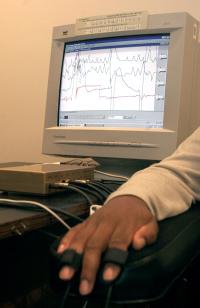Jun 25, 2025
A new form of surveillance state is quietly emerging—one that doesn’t need your consent, your awareness, or even your face to track you. It’s no longer about cameras or fingerprint scanners. Today’s digital sentinels are tuned into something far more intimate: the invisible rhythms of your biology.
This next phase in the biometric gold rush isn’t confined to facial recognition or iris scans. That’s old news. Instead, researchers and private firms—backed by government agencies—are investing in technologies that monitor your heartbeat, your respiration, and even your stress responses through ambient signals in your environment. You don’t have to wear a device or step into a scanner. You just have to exist within range.
One such effort is being led by a Canadian company called the P2P Group, in partnership with the U.S. Department of Homeland Security. Together, they are deploying remote sensing systems capable of detecting human life signs—heartbeat, breathing patterns, and potentially even emotional states—without physical contact or active participation from the subject. These systems can function through walls, in crowds, or at checkpoints, turning any space into a potential biosensor grid.
This isn’t science fiction—it’s emerging reality. Technologies like radar-based cardiography, RF-based respiration tracking, and passive Wi-Fi sensing are already in various stages of deployment or testing. The justification is usually public safety or national security. But as with many surveillance innovations, the line between protection and intrusion is blurry—and rapidly fading.
The real concern? These tools are being developed and tested without broad public debate, legal clarity, or ethical safeguards. In an age where data is currency and privacy is increasingly obsolete, your own heartbeat could soon become part of a digital dossier you never knew existed.
Prophecy Recon
.png)
 www.prophecyrecon.com
www.prophecyrecon.com
A new form of surveillance state is quietly emerging—one that doesn’t need your consent, your awareness, or even your face to track you. It’s no longer about cameras or fingerprint scanners. Today’s digital sentinels are tuned into something far more intimate: the invisible rhythms of your biology.
This next phase in the biometric gold rush isn’t confined to facial recognition or iris scans. That’s old news. Instead, researchers and private firms—backed by government agencies—are investing in technologies that monitor your heartbeat, your respiration, and even your stress responses through ambient signals in your environment. You don’t have to wear a device or step into a scanner. You just have to exist within range.
One such effort is being led by a Canadian company called the P2P Group, in partnership with the U.S. Department of Homeland Security. Together, they are deploying remote sensing systems capable of detecting human life signs—heartbeat, breathing patterns, and potentially even emotional states—without physical contact or active participation from the subject. These systems can function through walls, in crowds, or at checkpoints, turning any space into a potential biosensor grid.
This isn’t science fiction—it’s emerging reality. Technologies like radar-based cardiography, RF-based respiration tracking, and passive Wi-Fi sensing are already in various stages of deployment or testing. The justification is usually public safety or national security. But as with many surveillance innovations, the line between protection and intrusion is blurry—and rapidly fading.
The real concern? These tools are being developed and tested without broad public debate, legal clarity, or ethical safeguards. In an age where data is currency and privacy is increasingly obsolete, your own heartbeat could soon become part of a digital dossier you never knew existed.
Prophecy Recon  Joe Hawkins
Joe Hawkins
.png)
Your Heartbeat Is Now Under Surveillance | Prophecy Recon
 www.prophecyrecon.com
www.prophecyrecon.com




